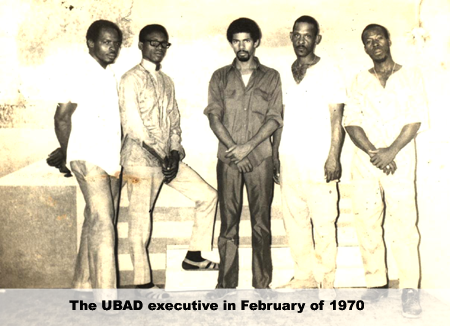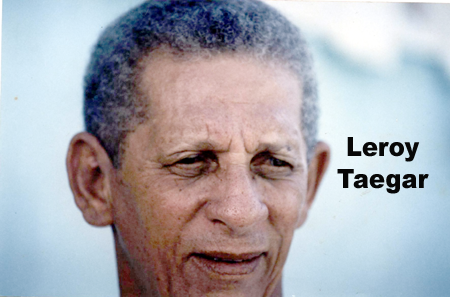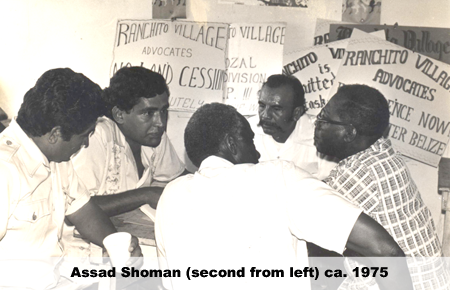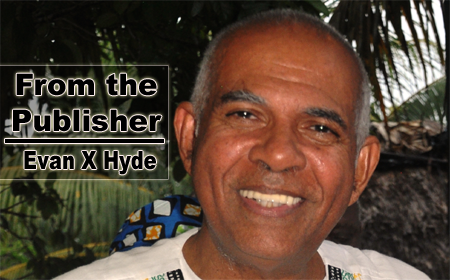There was a brief moment of hope and collective transformation in the late 1960s, when the younger, less-tolerant progeny of the civil rights era birthed the Black Power movement. To be called black was no longer an insult, it was liberating. Suddenly, many of us sported dashikis, raised clenched fists, shouted “Black Power” and “Black is Beautiful,” and sang James Brown’s “Say it Loud – I’m Black and I’m Proud.”
This movement influenced every area of our culture and gave rise to the black arts movement. It wasn’t just mainstream politics that changed, but education, music, fashion, and language shifted to reflect the demands of those who refused to go unheard.
– pg. 75, BRAINWASHED, by Tom Burrell, SmileyBooks, 2010
In February of 1970 the Cabinet of the ruling People’s United Party (PUP) made a decision to arrest and charge two leaders (myself and Ismail Omar Shabazz) of the United Black Association for Development (UBAD) with sedition (seditious conspiracy, to be precise). That PUP Cabinet decision, I would say, began a series of events which eventually led to a massive UBAD uprising in the streets of Belize City on the night of May 29, 1972 – 45 years ago.
On Monday morning of this week, the 45th anniversary of the May 1972 explosion, Lisa “Love” Myvett and Kareem “Frisco” Wallace, two KREM Radio announcers who host the “Morning Stew” show, asked me to speak on air about the events of the night of May 29, 1972. I could only give my personal observations of the night, because the principal actors in the dramatic events which followed the UBAD march were Secretary-General Norman Fairweather and two UBAD members, the late Michael Hyde (my younger brother) and Edwardo Burns (the older brother of River of Fire – the well-known poet).

Following the events of May 29, 1972, two UBAD officers (Fairweather and the aforementioned Shabazz), and ten UBAD members and affiliates were jailed for a week without bail at the old Her Majesty’s Prison on Gabourel Lane, where the Central Bank and the Belize Museum are now located. At the time, former UBAD officer, Charles X “Justice” Eagan, was a prominent member of the prison population, having been sentenced to jail after a Supreme Court trial in January of 1971. (In that trial, myself and Charles X Stamp were acquitted.) The imprisonment of the 12 ‘Badders then, and especially in the case of Shabazz, who had been converted to the Nation of Islam a decade earlier by the said Charles X Eagan, represented a reunion of sorts. Our people later said that Justice made sure they were well taken care of.
Underground in the streets of Belize City for the week our people were incarcerated (I had expected to be charged and jailed for conspiracy in connection with the May 29 events), I wondered if we would have to break our people out of jail. I wondered if the Government of Belize was going to hold them without bail indefinitely. But the PUP authorities offered bail after one week on remand.
Norman, Michael, and Edwardo were tried in Magistrate’s Court and in Supreme Court (October 1972 session) in connection with various charges arising out of their activities on May 29, 1972. The Magistrate who heard their several cases was the late George Brown, and the presiding judge at their Supreme Court trial was the late Albert Staine. The attorney Dean Lindo, who later became the first Leader of the United Democratic Party (UDP) after its foundation in September of 1973, defended the UBAD officer and members in all the trials, at both Magistrate’s Court and Supreme Court levels. (Belize being as small as it is, it should be noted that Lindo was married to Norman Fairweather’s older sister, Eva Elizabeth, at the time.)
For whatever his reason(s), Norman, to the best of my knowledge, has never spoken publicly of the events of May 29, 1972, and, needless to say, I wish he would.
In any case, I want to go back to the sedition arrest decision of the PUP Cabinet in February of 1970. As time went along, leading up to the July 1970 Supreme Court trial, the blame for the arrest began to be specifically attached to the Attorney General, Vernon Harrison Courtenay, who in fact chose to appear as a witness for the prosecution in Supreme Court.

During the preliminary hearing for the sedition trial, when the Government of Belize established their prima facie case, the prosecutor was a Trinidadian Crown Consul in Attorney General Courtenay’s office. (Incidentally, the Magistrate who officiated at the preliminary hearing was the late B. Q. Pitts, who had not yet qualified as an attorney.) His name was Theodore Guerra, but before our Supreme Court trial in July, Guerra had to fly home to Trinidad because there was a black power rebellion going on there at the time, in fact the most serious of all the black power rebellions in the Caribbean during that era.
In Trinidad, the rebellion included elements of the Trinidad army, led by Rex Lassalle and Raffique Shah, as well as civilians organized in the National Joint Action Committee (NJAC), led by Geddes Granger. (The Prime Minister at the time was Eric Williams.) A Belizean doctor was doing his internship in the Trinidadian capital, Port-of-Spain, at this exact time. His name was Leroy Taegar.

In later years, Leroy explained to me that Guerra had been sent for by the revolutionaries because he was considered an ally who could assist in their legal defence. But some of the revolutionaries came to the conclusion that Guerra was a traitor, and he was shot. (Leroy was working at the hospital the night when the injured attorney was brought in for emergency medical treatment.)
Now, the decision to arrest myself and Shabazz in August of 1970 was made, interestingly enough, just four or five weeks after the alliance between UBAD and the Assad Shoman/Said Musa People’s Action Committee (PAC), an alliance formed in October of 1969, had come to an end. During the time of the short-lived alliance between UBAD and PAC, a general election had been unexpectedly called that November and held in early December of 1969. The PUP, which had held 16 of the 18 seats in the House of Representatives, increased their total to 17, smashing a hasty coalition formed between Philip Goldson’s National Independence Party (NIP) and Dean Lindo’s People’s Development Movement (PDM).
There are two things to note here. One is that there had always been communication going on between PUP Premier George Price and Assad Shoman of PAC. The second thing to note is that UBAD had lost a lot of strength during our brief alliance with PAC. So that, the PUP, having destroyed the so-called NIPDM, may have felt that they might as well deal with UBAD before the organization recovered its popularity and strength.

In 1970, V. H. Courtenay, the son of Belize’s first Speaker of the House, W. H. Courtenay, V. H. having been elected to the House for the first time in the December 1969 general election, was considered a conservative, a right-winger. As soon as the February 1970 sedition arrest was made, Shoman and Musa offered to defend me and Shabazz free of charge. By the time of the 1979 general election, however, V. H. Courtenay was considered a left-wing ally of Assad’s and Said’s. But in 1970 Assad would have considered V. H. an enemy, and vice versa. (Personally, I had clashed verbally with Mr. Courtenay outside Salvation Army during the 1969 general election.) Assad’s influence on Mr. Price was growing, I submit, because Mr. Price felt he had to become more militant regionally in order to achieve independence for Belize.
The UBAD sedition trial of July 1970 became a somewhat sensational confrontation between prosecution witness, Attorney General V. H. Courtenay, and defence counsel Assad Shoman in cross-examination. Needless to say, I wish that Assad would talk and/or write about his experiences here which had to do with the sedition trial.

This week I saw some earnest bureaucrats on television reciting the “Flowers Bank 14” part of the historical narrative which the Baymen’s Clan has made official in Belize over the last ten years. This exact same Baymen’s Clan, several of whom benefited politically from the UBAD rebellion of May 1972, decided to participate in the obliteration of the history of that rebellion. Belize is a strange country. But, then again, perhaps Belize is not strange at all. Belize may simply be a place where white supremacy continues to rule, and decides what black people should and should not know and advises black people as to what they should and should not believe.
Power to the people.

